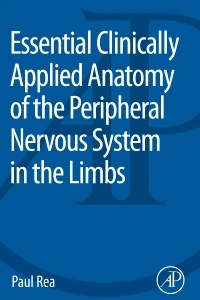Description
Essential Clinically Applied Anatomy of the Peripheral Nervous System in the Limbs
Author: Rea Paul
Language: English
Subjects for Essential Clinically Applied Anatomy of the Peripheral...:
Support: Print on demand
Description
/li>Contents
/li>Biography
/li>Comment
/li>
Essential Clinically Applied Anatomy of the Peripheral Nervous System in the Limbs is designed to combine the salient points of the anatomy of the PNS with typical pathologies affecting the nerves of the upper and lower limbs.
The book is a quick reference guide for those studying and treating neuromuscular disease such as neurologists, neurosurgeons, neuroradiologists, and clinical neurophysiologists.
Readers will find easy-to-access facts about the anatomy of the nerves in the limbs, coupled with clinically applied scenarios relevant to that area being discussed, as well as clinical findings on examination.
The book's purpose is to provide the reader with a succinct presentation of the relevant anatomy of the PNS in the limbs and how it is directly applicable to day-to-day clinical scenarios. It presents the reader with an easily accessible format to clinically applied PNS anatomy that is perfect for quick reference.
Chapters review the nerves of the upper and lower limbs, and the origins, course, distribution and relevant pathologies affecting each. These pathologies present typical injuries to the nerves of the PNS, as well as clinical findings on examination and treatments.
Chapter 1. Overview of the nervous system1.1 Divisions
Chapter 2. Upper limb nerve supply2.1 Overview of the upper limb nervous system2.2 Branches of the brachial plexus
Chapter 3. Lower limb nerve supply3.1 Overview of the lower limb nervous system3.2 Cutaneous innervation of the lower limb3.3 Motor and sensory nerves of the lower limb
During his time as an Associate Lecturer in Anatomy, he was awarded a scholarship to undertake a part time MSc in craniofacial anatomy alongside his teaching duties. His research won the Scottish Royal Medico-Chirurgical Society of Glasgow prize. He returned to clinical practice in pathology receiving training in all areas of histopathology, including post-mortem analysis.
He then returned to the University of Glasgow and was appointed as a University Teacher and subsequently Senior University Teacher. He is also one of the Licensed Teachers of Anatomy, appointed by St. Andrew’s House, Edinburgh. He teaches across the medical, dental and science programmes. He sits on many university committees and is a member of the Dental School Liaison Group. Paul has published in numerous journals and presented his work at many international conferences. He is also involved with public engagement with the Glasgow Science Centre as a Meet the Expert, and was key to the anatomical input to the international exhibition BodyWorks, and was a member of its Advisory Committee. He is also a STEM ambassador.
His research involves a successful strategic partnership with the Digital Design Studio, Glasgow School of Art. This has led to multi-million pound investment in creating world leading 3D digital datasets to be used in undergraduate and postgraduate teaching to enhance learning and assessment. This successful collaboration has resulted in the creation of the world’s first taught MSc in Medical Visualisation and Human Anatomy combining anatomy and digital technologies with internationally recognised leading digital experts. Paul is the joint Programme Coordinator for this programme.
- Provides a resource on the anatomy of the PNS nerves in the limbs, including key facts and summary tables that are essential to clinical practice
- Reports on typical injuries to the nerves of the PNS, as well as clinical findings on examination and treatments
- Presents a succinct, yet comprehensive, format with quick and easy access facts for quick reference
- Includes comprehensive chapters on nerves of the upper and lower limbs, discussing origin, course, distribution, and relevant pathologies
These books may interest you

Peripheral Nerve Disorders 236.94 €



